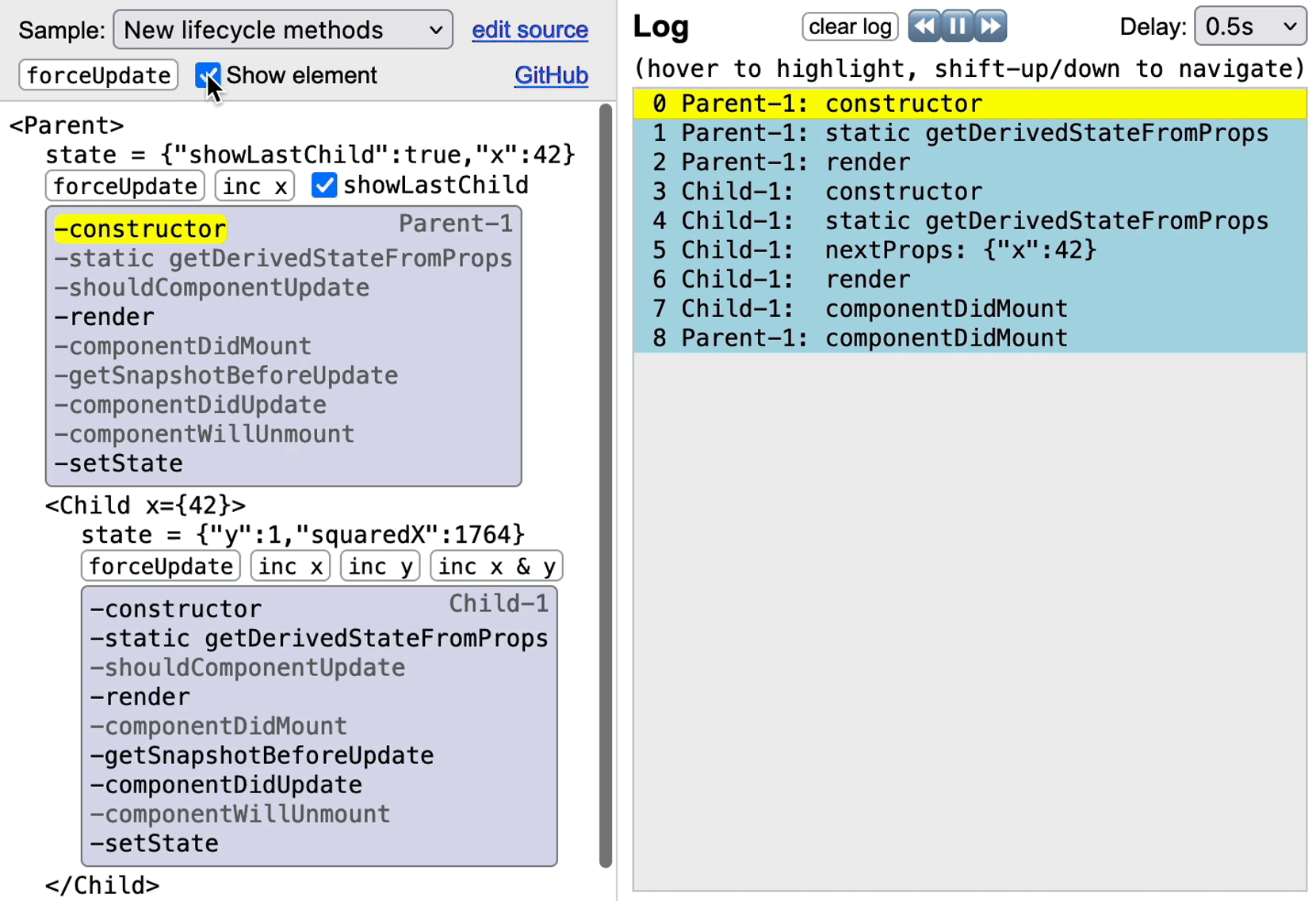React Lifecycle Visualizer 

An npm package (react-lifecycle-visualizer) for tracing & visualizing lifecycle methods of React class components. (For function components and hooks, check out react-hook-tracer instead.)
To trace a component, apply the higher-order component traceLifecycle to it, and all its lifecycle-method calls will show up in a replayable log component. Additionally, traced components may include a <this.props.LifecyclePanel/> element in their rendering to show a panel with lifecycle methods, which are highlighted when the corresponding log entry is selected.
Usage
The easiest way to get started is to
open the CodeSandbox playground and edit the sample components in src/samples. (For a better view of the log, press the 'Open in New Window' button in the top-right corner.)
The panel shows the new React 16.3 lifecycle methods, unless the component defines at least one legacy method and no new methods. On a component that has both legacy and new methods, React ignores the legacy methods, so the panel shows the new methods.
Though technically not lifecycle methods, setState & render are also traced. A single setState(update, [callback]) call may generate up to three log entries:
'setState'for the call itself.- If
updateis a function instead of an object,'setState:update fn'is logged when that function is evaluated. - If a
callbackfunction is provided,'setState:callback'is logged when it's called.
To save space, the lifecycle panel only contains setState, which gets highlighted on any of the three events above.
Run the demo locally
To run a local copy of the CodeSandbox demo, simply clone the repo, and run npm install & npm start:
git clone [email protected]:Oblosys/react-lifecycle-visualizer.git
cd react-lifecycle-visualizer
npm install
npm start
The demo runs on http://localhost:8000/.
Using the npm package
$ npm i react-lifecycle-visualizerSetup
To set up tracing, wrap the root or some other ancestor component in a <VisualizerProvider> and include the <Log/> component somewhere. For example:
import { Log, VisualizerProvider } from 'react-lifecycle-visualizer';
ReactDom.render(
<VisualizerProvider>
<div style={{display: 'flex'}}>
<App/>
<Log/>
</div>
</VisualizerProvider>,
document.getElementById('root')
);If you're using a WebPack dev-server with hot reloading, you can include a call to resetInstanceIdCounters in the module where you set up hot reloading:
import { resetInstanceIdCounters } from 'react-lifecycle-visualizer';
..
resetInstanceIdCounters(); // reset instance counters on hot reload
..This isn't strictly necessary, but without it, instance counters will keep increasing on each hot reload, making the log less readable.
Tracing components
To trace a component (e.g. ComponentToTrace,) apply the traceLifecycle HOC to it. This is most easily done with a decorator.
import { traceLifecycle } from 'react-lifecycle-visualizer';
..
@traceLifecycle
class ComponentToTrace extends React.Component {
..
render() {
return (
..
<this.props.LifecyclePanel/>
..
);
}
}Alternatively, apply traceLifecycle directly to the class, like this:
const ComponentToTrace = traceLifecycle(class ComponentToTrace extends React.Component {...});or
class ComponentToTraceOrg extends React.Component {...}
const ComponentToTrace = traceLifecycle(ComponentToTraceOrg);Traced component props: LifecyclePanel and trace
The traced component receives two additional props: LifecyclePanel and trace. The LifecyclePanel prop is a component that can be included in the rendering with <this.props.LifecyclePanel/> to display the lifecycle methods of the traced component.
render() {
return (
..
<this.props.LifecyclePanel/>
..
);
}The trace prop is a function of type (msg: string) => void that can be used to log custom messages:
componentDidUpdate(prevProps, prevState) {
this.props.trace('prevProps: ' + JSON.stringify(prevProps));
}In the constructor we can use this.props.trace after the call to super, or access trace on the props parameter:
constructor(props) {
props.trace('before super(props)');
super(props);
this.props.trace('after super(props)');
}In the static getDerivedStateFromProps we cannot use this to refer to the component instance, but we can access trace on the nextProps parameter:
static getDerivedStateFromProps(nextProps, prevState) {
nextProps.trace('nextProps: ' + JSON.stringify(nextProps));
..
}TypeScript
There's no need to install additional TypeScript typings, as these are already included in the package. The interface TraceProps declares the trace and LifecyclePanel props. Its definition is
export interface TraceProps {
trace: (msg: string) => void,
LifecyclePanel : React.SFC
}With the exception of tracing a component, the TypeScript setup is the same as the JavaScript setup above. Here's an example of a traced component in TypeScript:
import { traceLifecycle, TraceProps } from 'react-lifecycle-visualizer';
..
interface ComponentToTraceProps extends TraceProps {}; // add trace & LifecyclePanel props
interface ComponentToTraceState {}
class ComponentToTrace extends React.Component<ComponentToTraceProps, ComponentToTraceState> {
constructor(props: ComponentToTraceProps, context?: any) {
props.trace('before super(props)');
super(props, context);
this.props.trace('after super(props)');
}
static getDerivedStateFromProps(nextProps : ComponentToTraceProps, nextState: ComponentToTraceState) {
nextProps.trace('deriving');
return null;
}
render() {
return <this.props.LifecyclePanel/>;
}
}The only difference is that we cannot use traceLifecycle as a decorator in TypeScript, because it changes the signature of the parameter class (see this issue). Instead, we simply apply it as a function:
const TracedComponent = traceLifecycle(ComponentToTrace);

